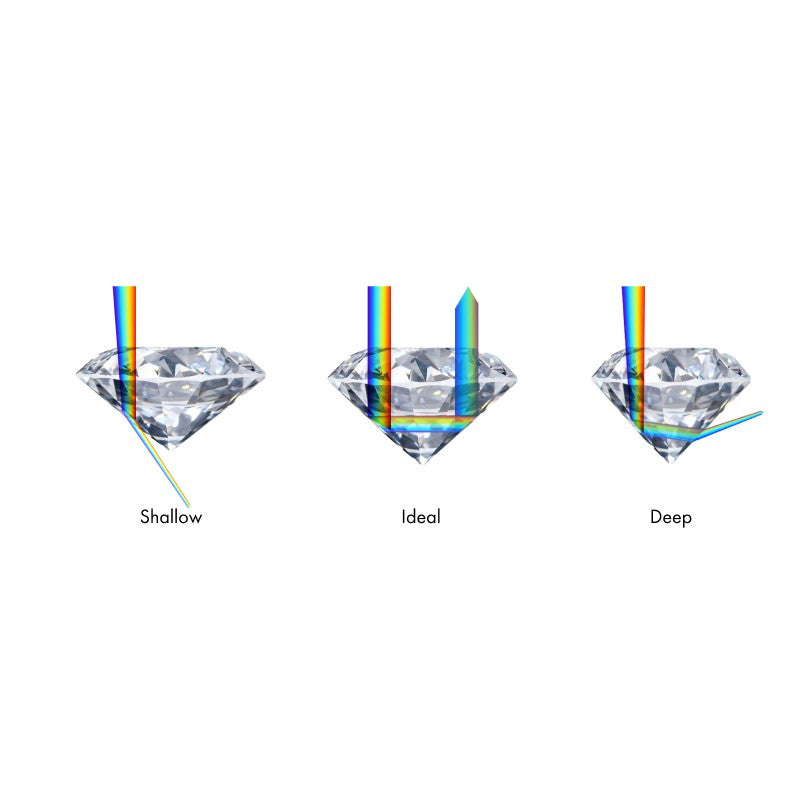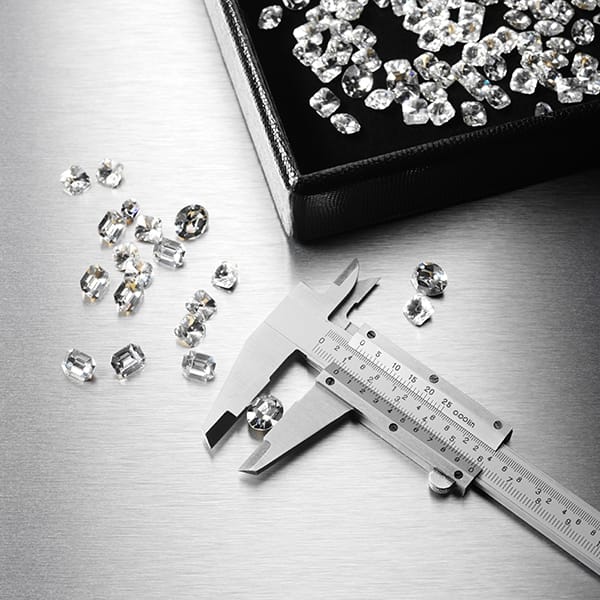
Purchasing a diamond is a very personal experience. The more you know about your diamond jewelry, the more confident you will feel when making the right choices.
Learn about shape, lab grown vs mined diamonds, and the four characteristics (AKA "Four Cs") below and how each play an important role in deciding which variation is right for you.

Anatomy of a Diamond
The anatomy of a diamond refers to the different parts and facets that make up its structure, each playing a crucial role in the diamond's overall appearance and brilliance.
-

Crown
The upper part of the diamond above the girdle, which includes the table and other facets. The crown's facets help disperse light into the diamond, contributing to its sparkle.
-

Table
The flat, topmost surface of the diamond, often the largest facet. The table allows light to enter and exit the diamond, influencing its brilliance.
-

Girdle
The narrow band that separates the crown from the pavilion. It is the widest part of the diamond and can be polished, faceted, or unpolished. The girdle's thickness can affect the diamond's durability and appearance.
-

Pavilion
The lower part of the diamond, below the girdle. It extends to the culet and is responsible for reflecting light that enters through the crown, enhancing the diamond's brilliance and fire.
-

Culet
The small facet at the very bottom of the diamond's pavilion. In some diamonds, the culet may be pointed, while in others, it may be a flat facet. A culet is usually small to prevent light from escaping through the bottom of the diamond.
-

Facets
The flat surfaces on a diamond's surface, cut to enhance its ability to reflect and refract light. The number, size, and arrangement of facets significantly affect the diamond's appearance and sparkle.

Shape
Often confused with the cut of the diamond, the shape of the diamond is the most important factor in finding a ring that fits your personality. Diamond shape refers to the geometric appearance of a diamond. Diamond shapes are categorised into two groups: round diamonds and fancy shape diamonds. Round diamonds, also known as round brilliant cuts, are the most traditional diamond shape. Fancy shape diamonds refer to any diamond that is not a round brilliant. Choose the shape that you like based on your style and you cannot go wrong.
The 4 C's

Cut
The cut of a diamond determines its brilliance or sparkle. Each diamond is cut differently based on different factors like the shape and the characteristics of the diamond such as flaws, the natural coloration. Every diamond is cut with facets in mind and try to get the best combination of size, shape, and clarity from the rough diamond. To maximize light performance, you will want a diamond that is cut neither too shallow nor too deep.

Color
Diamonds are graded based on the amount of color they do or do not possess. The scale runs from D (colorless) to Z (light yellow). An absolutely colorless diamond is rare and therefore very valuable.

Clarity
The clarity is judged by the number and types of these characteristics and is designated using a scale that runs from Fl, defined as flawless, to I3, defined as inclusions visible with the naked eye. A flawless diamond is truly rare.

Carat Weight
Carat is the unit of measurement for determining the weight of a diamond. A carat comes in at .2 grams. Carat weight is also divided into 100 points per carat to represent the diamond's size accurately. A 1/4 (.25) carat stone can also be expressed as 25 points and means the same thing. When comparing a 1ct and 2ct diamond, it is important to remember that the 2ct diamond's size will not be double, only the weight.
Lab Grown Diamonds
What is a lab grown diamond?
Lab grown diamonds, also called lab created diamonds or man made diamonds, are diamonds that are created in a controlled laboratory environment. Lab grown diamonds have the exact same physical, optical, and chemical properties as Earth's mined diamonds. Lab diamonds have the same carbon atom crystal structure as natural diamonds, which gives them the same superior hardness and spectacular beauty. The only difference between lab grown and mined diamonds is how they are created.
When scientists create a diamond in a lab, they replicate how diamonds form in the Earth’s crust. Natural diamonds formed many years ago deep below the Earth’s surface. In the Earth, carbon atoms crystallize due to the intense heat and extreme pressure surrounding them, which creates diamonds. When scientists replicate this process in a lab, they use one of two methods: high pressure high temperature (HPHT) or chemical vapor deposition (CVD).
With the HPHT method, scientists start with a diamond seed, a tiny piece of a diamond. They then place this diamond seed into a controlled chamber and surround the diamond seed with pure carbon. Next, they expose these two materials to very high pressures and temperatures. These conditions cause the pure carbon to melt and bonds around the diamond seed. The carbon bonds to the diamond layer by layer, growing each day and eventually creating a lab grown diamond.

Schedule an Appointment
Choose a convenient date and time to meet with a jewelry expert, who will guide you through our selection of fine jewelry and assist with any custom requests or repairs. Whether you're looking for the perfect engagement ring, a special gift, or a custom design, scheduling an appointment ensures personalized attention and a tailored shopping experience.
-
Questions? Concerns?
-
Peace of Mind Protection Plan
-
Financing
-
Find a Location









